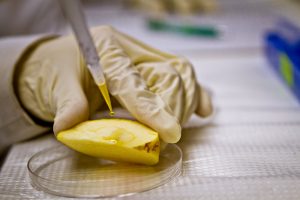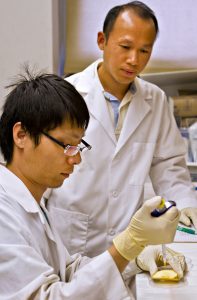
Nanomaterials are increasingly used in water treatment, food packaging, pesticides, cosmetics and other areas. There is a growing concern that these particles could pose a potential health risk to humans and the environment. In a new study, researchers at the University of Missouri have developed a reliable method for detecting silver nanoparticles in foods.
“More than 1,000 products on the market have nanotechnology-based technology associated with them,” said Mengshi Lin, associate professor of food science at the College of Agriculture, Food and Natural Resources. “This is a concern because we don’t know the toxicity of nanoparticles. Our goal is to detect, identify and quantify these nanoparticles in food and food products and study their toxicity as soon as possible.”

Lin and his colleagues, including Azlin Mustapha and Bongkosh Vardhanabhuti, both associate professors of food science, studied the residue and penetration of silver nanoparticles on pear skin.
Washing Doesn’t Help
First, the scientists immersed the pears in a silver nanoparticle solution similar to a pesticide application. The pears were then washed and rinsed repeatedly. Results showed that four days after the treatment and rinsing, silver nanoparticles were still attached to the skin, and the smaller particles were able to penetrate the skin and reach the pear pulp.
Silver nanoparticles are used as a pesticide because of their capability to suppress the growth of harmful organisms.
“The penetration of silver nanoparticles is dangerous to consumers because they have the ability to relocate in the human body after digestion,” Lin said. “Therefore, smaller nanoparticles may be more harmful to consumers than larger counterparts.”
Impacting the Body’s Vital Sites
When ingested, nanoparticles pass into the blood and lymph system, circulate through the body and reach potentially sensitive sites such as the spleen, brain, liver and heart.
A nanoparticle is defined as a particle smaller than 100 nanometers – about the size of a molecule. One million nanometers will fit into one millimeter.
Nanoparticles are manufactured for use in an array of applications such as cosmetics, material coatings and as a fuel additive. They are being increasingly investigated for use in medical applications such as drug delivery and release.
The growing trend to use other types of nanoparticles has revolutionized the food industry by enhancing flavors, improving supplement delivery, keeping food fresh longer and brightening the colors of food.
“This study provides an effective approach for detecting the contamination of silver nanoparticles in food crops or other agricultural products,” Lin said.
Members of Lin’s research team included Zhong Zhang, a food science graduate student. Their research on silver nanoparticles and pears was recently published in the Journal of Agricultural and Food Chemistry.